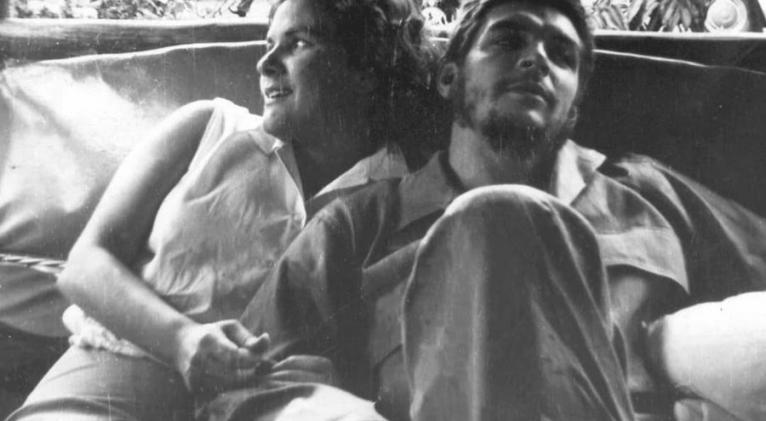Aleida March Kisses and Tells All in New Memoir about Che Guevara, Herself and the Cuban Revolution
especiales

In one of her best-known songs, Tina Turner, the “Queen of Rock ‘n’ Roll,” asks, “What’s love got to do with it?” For Che “it” was everything. His second wife, Aleida March, provides much the same idea in her story of romance and revolution, perhaps the most romantic of reveries. Now 87 and older than the Cuban Revolution— and more than 50 years after the death of Che who died at the age of 39— March has written a memoir that might be called an official
version of her life as “Mrs. Guevara,” as she was sometimes called.
Remembering Che: My Life with Che Guevara was originally published in Spanish as Evocation: My Vida al lado del Che. (“al ado’ translates as beside. That she was.) Her memoir has just been republished in the US by Seven Stories in an English language edition translated adeptly by Pilar Aguilera. Over the course of the last few years, Seven Stories in New York has published Che’s MotorCycle Diaries and his diaries of the Congo and Bolivia. March helped with editing and by writing introductions to those volumes.
In Remembering Che she pours out her love for Che, for their children, who are now adults, for the Cuban revolution, Fidel Castro and the world-wide movement against imperialism. A loyal comrade, March would surely echo Che who said, “At the risk of seeming ridiculous, let me say that the true revolutionary is guided by a great feeling of love.“ March probably would not have added the phrase “at the risk of seeming ridiculous.” True love and true revolutionaries were never ridiculous in her world-view
Remembering Che offers a rare and never-before-seen portrait of the Argentinian-born doctor who became Fidel Castro’s right hand man and who helped to overthrow the dictatorship of Fulgencio Bautisa. At the same time, Aleida also depicts Che in familiar poses as a larger-than-life hero of the revolution. In her book, she relies on her own memories and recollections (she expresses some doubts about the record she provides). She also uses Che’s own words and seemingly contradictory statements.
On the one hand, he called himself “a tough guy” and “the future in progress.” On the other hand, he noted that he was “an adventurer and a bourgeois.” He might have added that he was also a bureaucrat, at least when he served briefly as the president of the Bank of Cuba, which issued currency that included his signature. Aware that he was viewed in some circles as a “mechanical maniac,” he also noted that as a leader he had to repress “personal feelings.” That goal proved to be impossible. “My need for you is virulent,” he told Aleida. He could sound like a teenager in love.
Aleida writes that Che was not present for the execution of “counterrevolutionaries.” Wikipdea says that he reviewed the appeals process and the firing squads.
In many ways, Che and Aleida shared a traditional courtship and marriage. Before their wedding, and when Che still had a wife and child in Argentina, they often slept in separate rooms and separate beds, Aleida writes. When he went to work in his austere office as bank president, March usually stayed at home to raise their children, attend to domestic duties that included paying the rent, cooking and cleaning. She also worked for the Cuban government as Che’s personal secretary, a position she guarded like a lion.
On occasion, she accompanied her husband on diplomatic missions when he met for example Salvador Allende in Chile. Sometimes March was excluded by Che himself from government meetings, an act she took personally and that triggered her insecurity and jealousy. She complained.
Aleida reveals almost all and tells almost all; she names her gynecologist, though she does not describe sex with Che. She, too, could be bourgeois as well as an adventurer. She enjoyed wearing stylish clothes and retiring her drab guerrilla fatigues. Aleida went out of her way to wear a white dress at their wedding ceremony, and like a dutiful wife she cared about her husband’s grooming and appearance. He didn’t mind his funky attire and must have smelled of the pipe tobacco and cigars he smoked and that didn’t help his poor health. He was an addict to the end of his days, devoted to his pipe.
Aleida, who was born in 1936 and raised in Cuba, was a decade younger than Che. As a young woman, she served as a foot soldier in the revolutionary war and went on dangerous missions for the guerillas, transporting cash and explosives. Initially a Cuban nationalist and an anti-communism by her own reckoning, she served in the clandestine urban network. Che’s first wife, Hilda Gadea, and his parents thought of Aledia as a girl “from the sticks” and said so.
In some ways, Che and Aleida enjoyed a traditional marriage. He went to the office while she stayed at home, raised their children, and cooked and cleaned. In hindsight, Aleida sees Che as a rather conventional lover who clammed up when he might have been candid. Born in the clandestine, their relationship was defined by the clandestine, even after the revolutionaries came into power. Such is in the nature of underground life. Once secrecy and subterfuge starts it’s hard to stop. Aleida managed to carve out what she calls an “intimate space” where their relationship could grow and be nourished.
What is to be gained from reading Aleida’s memoir? That revolutionaries are not what they seem to be, that making a revolution is more difficult than rebels imagine, and that love born in a bourgeois society doesn’t lose its bourgeois roots, though the lovers try.
Aleida has kept the Che flame burning brightly ever since she learned that he was assassinated in Bolivia at the hands of Bolivian soldiers and the CIA. Now, the head of the Che Guevara Studies Center in Havana, she has witnessed, she says, the collapse of the global socialist camp, the rise of “hegemonic neoliberalism” and the coming into adulthood of her and Che’s children who do their part to invigorate and sustain Cuban culture. Remembering Che ensures Aleida a secure place in the pantheon of Latina revolutionaries.
Jonah Raskin is the author of Beat Blues, San Francisco, 1955.














Add new comment